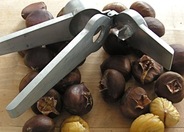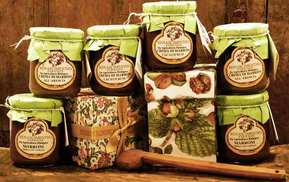|
Every fall when I was a kid, just before Thanksgiving, my Dad would bring home a bunch of chestnuts from his store. On Thanksgiving day--and on Christmas, too--he'd cut crosses on the sides and put them up in a broiler pan to roast in the oven. Toward the end of the huge day of eating (pasta dinner first, then rest for a hour or two before the American style turkey dinner) the chestnuts would be on the table with the tangerines, kumquats, "Chinese Apples" (pomegranates) and Italian pastries. This is also when my Dad would get out the tiny aperitivo glasses on a round carrying tray, each looking like little glass mugs with handles. I can still remember the smell of the roasted chestnuts and Amaretto wafting into my young nose. Of course, my Dad would always let me have a sip or two. And even though I wasn't a big fan of chestnuts back then, I still had a couple with my tangerine. Perhaps because I sensed the tradition was important to my Dad, or maybe simply because HE had bought and roasted them.  Castagne (Cast-AH-nyeh) have been cultivated for over 2000 years and were imported into Italy and the rest of the European continent from the Near East and Turkey. Ancient Greek writers--Dioscorides and Galen--wrote about the chestnut's health benefits while warning of the flatulence caused by overindulging. Early Christians thought chestnuts symbolized chastity. Communities in mountainous and forested areas of Italy relied on chestnuts as their main source of carbohydrates, and in some regions, a cake made of chestnuts is used as a substitute for potatoes. The European Chestnut can grow to 60 feet tall, or can be quite bushy. There have been reports in history of some trees reaching 50 feet in circumference around the trunk. But, just as with the huge, ancient 2000 year old olive trees we saw in Puglia, some trees love Italy so much and seem to live forever. Il Castagno dei Cento Cavalli (Chestnut of 100 Horses) on the eastern slope of Mount Etna in Sicily is the oldest known chestnut in the world, estimated to be between 2000-4000 years old! The tree's name comes from a legend about The Queen of Aragon and her army of one hundred knights being able to take shelter under the massive tree during a severe storm. In the 1700s its then intact trunk measured almost 200 feet around. Today, the tree's trunk is split into several different sections, but all are growing from the same roots and are still alive. The Mugello area in northern Tuscany is no doubt the heart of chestnut cultivation in Italy. In fact the Mugello Sweet Chestnut has been given Protected Geographic Indication status by the European Union. It is sweeter than others, peels easily and supposedly tastes of vanilla, hazelnut and the scent of fresh bread.  Montebianco (Mont Blanc) dessert Montebianco (Mont Blanc) dessert Although you can eat chestnuts raw, the flavor can be a bit astringent. The best way to enjoy them is roasting, although they can also be candied, boiled, steamed or deep-fried. For roasting, the outside of the fruit needs to be scored (yes, chestnuts are actually fruits) to prevent them from exploding. The texture is something like a dry baked potato with a sweet, nutty flavor. The flavor can be enhanced by tossing in sugar or a cinnamon-sugar mix. Some even toss them in a bit of melted butter. Chestnuts are used in many different ways: milled into flour for bread (long lasting!), cakes, pastas or polenta; to thicken soups and sauces; to make fritelli (fritters); candied or pureed and sweetened for desserts or as spreads; as an element of stuffing for turkey or goose; as a substitute for potatoes in stews; Tuscan chestnut cake; and in as a Montebianco dessert in Italy. The chestnuts in Europe--especially in Italy--are superior to the ones we typically find in American supermarkets. If you can, find someone who carries imported Italian Sweet Chestnuts. If not, there is always Amazon. Otherwise, here's a method of roasting chestnuts that won't dry them out while adding a bit more flavor:
Of course, chestnuts need to be eaten right away--as soon as you can touch them without burning your fingers. (Ouch). Peel. Eat. Peel a tangerine to go along with them. Sip some Amarreto. Tradition. Buon Giorno del Ringraziamento a tutti! (Happy Thanksgiving, that is.) e Buon Natale! (Merry Christmas, too!) --Jerry Finzi
If you enjoyed this post, please LIKE it and SHARE with your amici... grazie! We also have pages on: Google+ StumbleUpon
1 Comment
Lillian Jane Steele
12/15/2020 11:10:15 am
Love this site. Looking forward to learning more.
Reply
Your comment will be posted after it is approved.
Leave a Reply. |
Categories
All
Archive
June 2024
|











 RSS Feed
RSS Feed
